Draba verna
Draba verna common whitlowgrass
This is one of the earliest annual plants to bloom during the spring and is often missed by hikers because of this. It tends to grow in dry, sandy, sunny locations and do well in extremely shallow soil.
The flowers open when the weather is warm and sunny, but otherwise remain closed. There are 4 white petals that are so deeply notched that there often appeared to be 8 petals. In some ways, the flowers resemble those of chickweeds, but most of those have five split petals. Whitlowgrass is a member of the mustard family, a group that typically has four petals. Its common name is not accurate since it is not really a grass. It is also named for a medical condition called whitlow, an abscess in the soft tissue near a toenail or fingernail. Herbalists formerly used the plant to treat this condition.
The plants were only 1 to 1.5 inches high at most, though they can sometimes grow taller. A single flower (about 1/8 to 1/4 inch in diameter) is not very impressive, but growing in such a mass they were quite a beautiful sight. The 4 petals are white, but the 6 anthers in the center are yellow. There is a single green pistil. The flowers produce nectar that attracts Halictid or Andrenid bees. If the colonies are dense, they may attract honeybees if the weather is warm enough. Because insects are sparse early in the spring, the flowers also self-pollinate.
After fertilization, a seedpod is produced that contains about 40 seeds. The pod is on a long stalk and is shaped like a flattened American football. The life cycle is very rapid and the plants flowers are gone in a few weeks. There is a small cluster of basal leaves that are lightly hairy. The leaves are 1 inch long or less. The flowering stem is very thin and had no leaves. The roots are shallow and fibrous. It is a highly variable species with individual plants varying in flower size, hairiness and even chromosome number.
This species is common in both eastern and western United States, but the southern part of Western Pennsylvania is close to the northern edge of its range. It is also found in Europe, North Africa and parts of Asia. At one time it was thought that it had been introduced by colonists to North America, but now is thought to be a native plant here also.
Habitat & Range
Grows in meadows, fields and other man-disturbed habitats.
Mostly found in southern parts of the state.
Wetland code: Not classified
Phenology
Flowers from end of March to end of April. Blooming period is 2 to 4 weeks.




Comments
Have you spotted this plant in your area? We'd love to hear about your experience! Share your comments or questions about the plant below. Comments are moderated before posting.